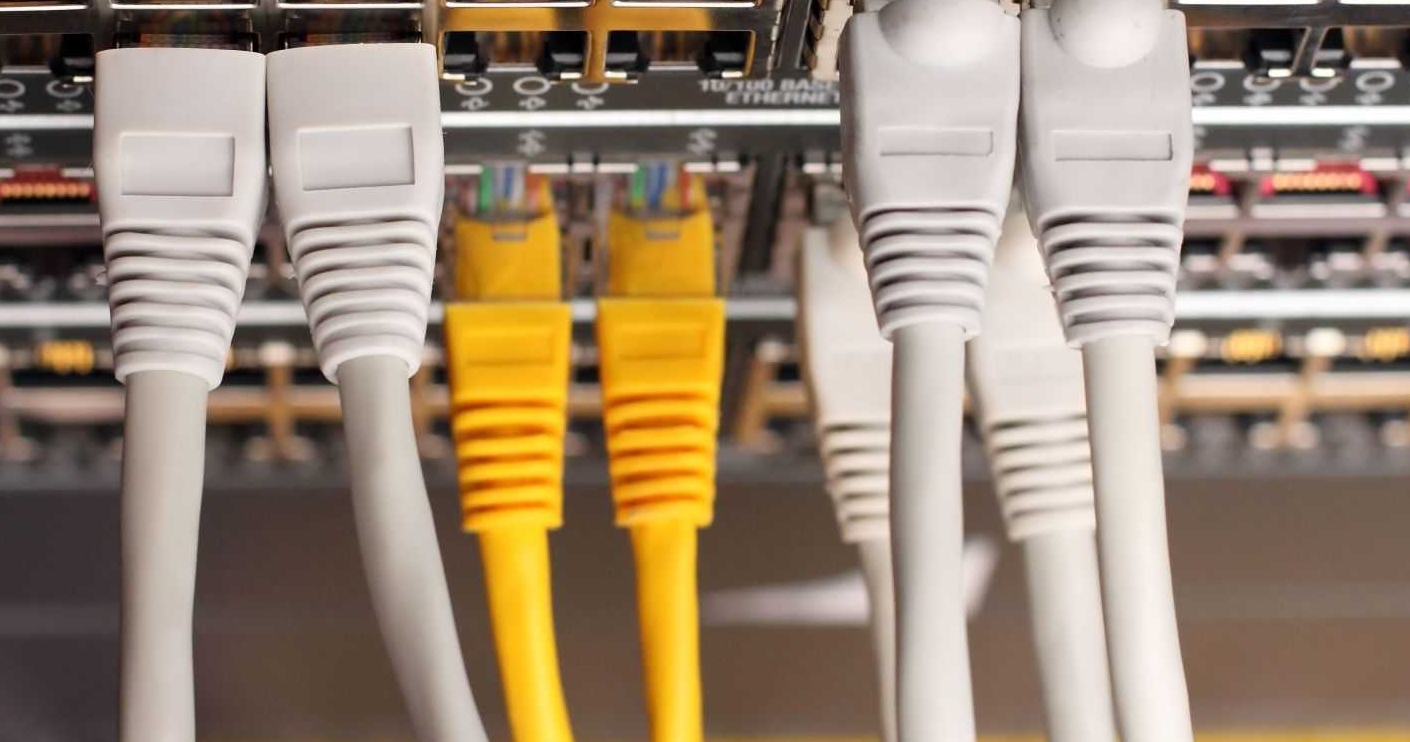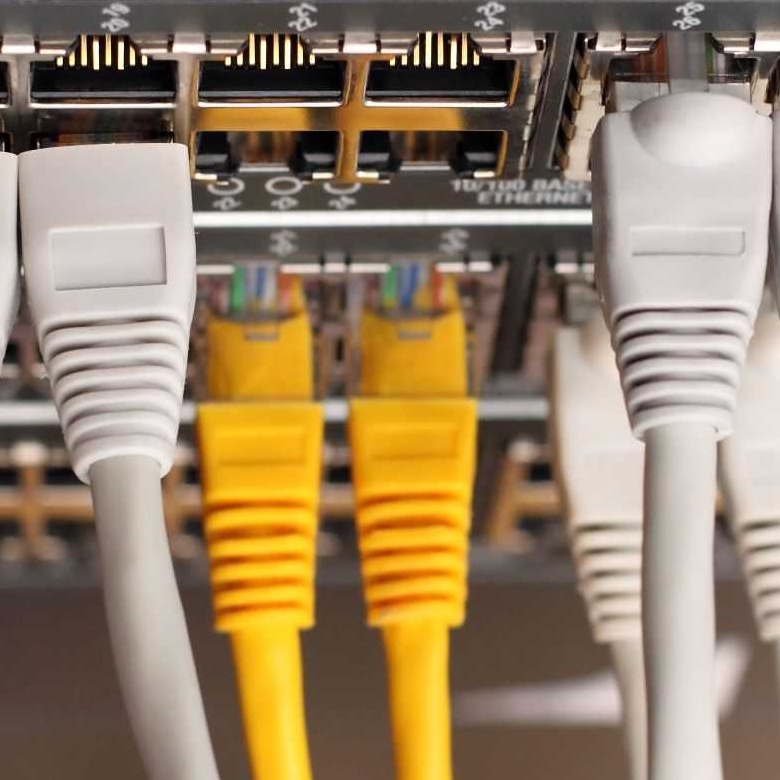
Dante®: real-time audio networks
AoIP technology is more agile and efficient with Dante®
AoIP (Audio over IP) makes it possible to implement sound reinforcement with a normal IP network. This means effective sound reinforcement via normal LAN cables, free of interference and loss over long distances. For many years this has been an appropriate solution for background music, streaming and radio transmissions, for example in department stores or fitness studios. Live audio applications, however, were previously impossible to implement with an IP network. This is because IP networks are not designed for real-time transmission and therefore cause latencies. With preloaded background sound this is irrelevant. But live concerts, recording studios, broadcasting, live debates or larger sound installations place high demands on the transmission speed, real-time capability and operational reliability of the network. This now works with Dante®.
Dante® is the next step for digital audio networks
Dante® stands for Digital Audio Network Through Ethernet and refers to an audio networking technology. It consists of three components:
- The hardware modules: speakers, amplifiers, switches, speaker management systems
- The software: the Dante® Controller as control software or the Dante® Domain Managers for cross-IP control of Dante® components.
- The network protocol itself: the network protocol is the digital method of communicating the rules, syntax and encryption used to transfer data packets between hardware and software.
These respective components then require a factory installed Dante® module. Only then they also use the Dante® network protocol. Externally, a Dante® network is not much different from a conventional Audio over IP network, because with Dante®, audio data can also be transmitted via a normal network cable (CAT5e, CAT6 or optical fibre cable). The only difference is the changed network protocol. Therefore, is Dante® basically a further development of Audio over IP technology.
With the Dante® Virtual Soundcard any computer with a LAN connection can be used for a Dante® network.
The selected LAN port on the computer functions as a Dante® audio interface with up to 64 inputs and outputs. You can think of it as a classic audio interface - only virtual.
4 advantages of Dante®audio networks over other AoIP networks
1. Dante® makes Audio over IP usable for real-time applications
The best example is a live performance: since in such cases several instruments, mixing consoles and loudspeakers are active, even small delays in the transmission can completely 'fray' the sound. Live podcasts or broadcasting applications are other examples where real-time transmission is required. Although latency is also dependent on the number of devices and cable paths, even with Dante®, the latency is not always the same.
But even in large networks, latency does not exceed 5 milliseconds and is therefore not noticeable to humans.
2. Auto-Discovery: Dante® devices always detect Dante® devices
Devices with a Dante® interface will automatically detect each other in networks after initial configuration. When a Dante® unit is connected to another Dante® unit, either directly or via a network distributor, the units are immediately visible and controllable in the network.
With Dante® there is no more annoying configuration via the device manager and no more driver and firmware chaos.
Dante® makes true networking of audio devices possible: no longer does one device send in one direction to all other devices, but all devices can send and receive via Dante® module. As Dante® devices immediately identify each other in the network it is very easy to set up an audio network with Dante®: all the devices for the sound system are connected to an Ethernet switch, a computer dials into the network, and that's it. Users can now manage the audio network by computer.
3. Dante® is the network protocol for high performance
Dante® offers integrated Gigabit support. And we strongly recommend that you take advantage of it. Although Dante® will work at speeds of 100 Mbps, it will work with fewer channels, depending on what else is transmitted via the LAN network. Even for a medium sized network, the only way to ensure trouble-free transmission of large amounts of data is with a Gigabit network splitter.
At a transmission rate of 1 Gigabit per second, 512 forward and return channels are possible at a sampling rate of 48 kHz. It is important that the network splitter provides the option to prioritize certain data packets within the network.
Time-critical data packets, i.e. individual audio tracks that belong together and must be played synchronously, can be prioritized by the network distributor, to minimize the latency. Due to the digitalisation of the audio signal, cable paths in Dante® networks can be up to 100 metres long (without active components), in optical fibre networks even significantly longer. This makes Dante® particularly suitable for installations where devices are far apart, such as stadiums, educational institutions, city halls or museums.
4. Dante® uses a pre-configured word clock
This word clock is already integrated and preconfigured in the Dante® module. Without this word clock, all devices in the audio network would play back a slightly shifted signal and an asynchronous sound. Dante® devices synchronize automatically. The user can choose which device "sets the beat".
Configured as the master a single Dante® device is sufficient in the entire setup to synchronize all other devices.
The Dante® Controller and Dante® Domain Manager: managing audio networks without prior knowledge
One of the biggest disadvantages of Audio over IP technology, and ultimately of any audio network, was the major entry threshold for the end user. Basic IT skills were required to manage and set up audio networks. With the Dante® controller, many options for diagnostics, monitoring and configuration are easily accessible.
Especially the complex routing is very easy. In the past, an electrical installer had to do this with physical splitters, i.e. with additional hardware. Today, this is done entirely by software.
The Dante® Domain Manager adds another level of convenience: it lowers the entry threshold by making all possible functions and best practice settings easily accessible. Users can divide and structure large networks into sub-areas with just a few clicks. The status of the network and its sub-areas are visualized and can be seen at a glance. The Dante® Domain Manager can also manage multiple users who need to authenticate before accessing the network. Different users can have different rights in the audio network. This is particularly interesting for larger networks: certain employees can then change the sound system in their area of responsibility via a central computer, but not anywhere else.
The Dante® Domain Manager offers even more comfort functions, control and operational security:
- Detailed log functions about the settings made on the network
- Backup and restore functions
- Dashboards and alerts for specific status changes in the network
- Support of virtual servers (VS support)
- Customisable user interface
Conclusion: Dante® is becoming increasingly indispensable in audio networks.
Of course, IT or network experts can find the perfect configuration by themselves, write logs themselves or create audio networks with splitters. But when it comes to real-time applications, where sound delays are unwanted or even a knockout criterion, Dante® is a necessity. Because Dante® is the only reliable way to implement synchronous sound reproduction for multiple channels. And the more live clubs, conference centres and event venues are equipped with existing network infrastructure, tthe more economically efficient Dante® solutions are compared to standard ELA technology.
source image header: MWiner – stock.adobe.com

